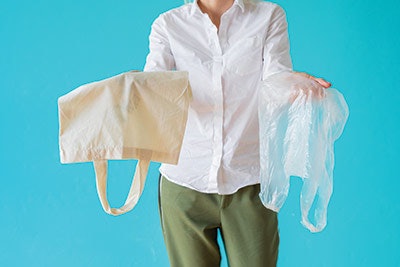
A few years ago, I had to visit our local waste management authority. I was appalled at what I saw there. The line of trucks waiting to dispose of trash was long, and each vehicle was packed with furniture, building materials and anything else you can imagine. I felt sad and disgusted as I faced the reality of how much humans consume and discard without realizing (or caring) that they’re depleting natural resources and increasing pollution with every passing second. The environmental, economic and social impacts are disheartening.
Our species needs to reflect on the effects we’re causing. We need to step up our efforts to reduce, reuse and recycle. I realize it can seem overwhelming to think about how we as individuals, company managers and business owners can develop and stay true to sustainable practices.
Naturally, people think, “We’re only one person or one company.” But in the wise words of Margaret Mead, “Never doubt that a small group of thoughtful, committed citizens can change the world; indeed, it’s the only thing that ever has.”
So, how about taking a step right now toward changing the world? Let’s explore what “zero waste” means, what its benefits are, and what actions you can take to get closer to the goal of zero waste.
What is Zero Waste?
Zero waste is a strategy, whether taken on by an individual or put into place within a business. It ensures everyone has access to the tools needed to reduce, reuse and recycle waste where we live, work and play. Zero waste protects the health of communities by keeping waste and toxins out of landfills and incinerators, thus reducing pollution in the air, water and soil.
For companies, does zero waste mean they must avoid sending any amount of trash to landfills? Or does it mean eliminating all waste byproducts? Reaching zero waste might seem physically impossible, so it’s commonly accepted that getting within 2% of that—or diverting 98% of waste through reducing, recycling or reusing–fits the criteria.
"Our species needs to reflect on the effects we're causing. We need to step up our efforts to reduce, reuse and recycle."
According to Zero Waste International Alliance, “Zero Waste is a goal that is ethical, economical, efficient and visionary, to guide people in changing their lifestyles and practices to emulate sustainable natural cycles, where all discarded materials are designed to become resources for others to use. Zero waste means designing and managing products and processes to systematically avoid and eliminate the volume and toxicity of waste and materials, conserve and recover all resources and not burn or bury them. Implementing zero waste will eliminate all discharges to land, water or air that are a threat to planetary, human, animal or plant health.”1
Why Zero Waste?
As with everything in life, it’s best to approach a zero waste strategy intentionally. There must be an understanding of the purpose and an objective. Ask “What’s my ‘why’?” and look ahead to the future to bring clarity and a sense of purpose to your efforts. According to TerraCycle, “Over the past 100 years, the amount of waste that humanity produces has increased by almost 10,000%. Of that staggering volume, it is estimated that 25% ends up in our oceans, forming five gigantic gyres of garbage.”2
If you are considering taking steps toward becoming a zero waste business or have a less intensive goal of adding sustainable practices to your operations, the benefits are impressive.
1. Cut costs. Save money on waste management costs.
2. Increase revenue. Being a good steward of the environment can give you a competitive advantage. If sustainable practices are important to you, they are most likely important to your target market. Customers are becoming increasingly aware of and partial to ethical and environmentally friendly businesses.
3. Reduce impact on the climate. Recycling helps to reduce greenhouse gas emissions by reducing energy consumption.
4. Conserve resources. Using recycled materials to make new products reduces the demand for virgin raw materials mined or otherwise extracted from the earth.
5. Minimize pollution. Less waste processing means lower amounts of greenhouse gases and water pollutants released into the environment. Using recovered materials generates less solid waste that eventually would end up in landfills, and it helps reduce the pollution caused by extracting and processing virgin materials.
Get Started
1. Measure what matters. Start with measuring your waste footprint. Set up waste sorting stations for office paper, magazine, Styrofoam, plastic bags, breakroom waste (including pre-packaged food materials), etc. After sorting, weigh the waste outputs, including recyclable and non-recyclable materials weekly. Doing so helps gain insight into what our typical waste footprint truly is. After taking stock of the non-recyclable materials you’re disposing of, consider if there are recyclable alternatives that you can use instead going forward.
2. Create a plan. This is where the fun happens! Ask your team to get involved in brainstorming ways to make an impact.
- How and where will sorting stations be located?
- Can the team reduce or avoid pre-packaged food items by using reusable packaging like glass storage containers?
Or consider setting up a “no disposable plasticware utensils” pact. Get the team involved to make the optimal impact from your efforts.
3. Set goals. Setting goals is an essential component of launching a zero waste process. After you’ve determined what you plan to measure, determine where you are now and establish objectives for where you aspire to be. Having goals drives motivation and incentivizes you to gauge the impact your efforts are making.
 4. Shop contentiously and evaluate your supply chain. Buy green products that have minimal impact on the environment—such as all-natural, plant-based cellulose sponges, rather than foam sponges. Also, purchase durable products that last longer, rather than cheap items that you will toss into the trash after a few uses. Make an even bigger impact by buying from companies who have sustainable practices in place.
4. Shop contentiously and evaluate your supply chain. Buy green products that have minimal impact on the environment—such as all-natural, plant-based cellulose sponges, rather than foam sponges. Also, purchase durable products that last longer, rather than cheap items that you will toss into the trash after a few uses. Make an even bigger impact by buying from companies who have sustainable practices in place.5. Reduce. Consider “low hanging fruit” initially. In other words, do what’s easy and then enhance your processes as you become more intuitive about reducing waste. Consider ways you can purchase less, thus eliminating waste as a result. Consider repairing electronic devices rather than dumping them and buying new gadgets. Reduce electric use by turning off lights when leaving a room, unplugging electronics when you’re not using them or installing lights with sensors. Some ways to reduce water use are to make sure faucets don’t run continually and install water-efficient showerheads, faucets, toilets, washing machines, dishwashers and other water-saving products.
6. Reuse and upcycle. Consider ways items can be reused and repurposed. For example, spa linens that are stained or torn can be collected in a Fabric & Clothing Zero Waste Box from TerraCycle so that “the collected fabrics are segregated into their respective categories (such as nylon, cotton, etc.) and then either reused, upcycled or recycled as appropriate.”
7. Recycle. Recently, recycling in the U.S. has evolved dramatically, thus reducing what can and cannot be recycled. Due to these changes, creativity is key. We can recycle non-allowed recyclable materials such as Styrofoam, magazines, newspapers, batteries, e-waste and other disposable items through various local initiatives. For the other non-recyclable waste materials, use companies such as TerraCycle whose goal is to “focus on hard-to-recycle materials, developing circular solutions for otherwise linear systems.” They recycle millions of pounds of typical non-recyclable materials every week, diverting it from our landfills and incinerators. Consider making recycling more convenient for your staff by placing a small recycling basket in each treatment room, particularly esthetics rooms. Many product bottles (without the cap) may be recycled. Minimize waste at your business to maximize zero waste efforts everywhere.
It Adds Up
Even small efforts to reduce waste can add up. The more companies that take steps closer to running a zero-waste operation—even baby steps—the more positive changes we’ll see locally, regionally, nationally and globally. I encourage you to start thinking through a plan for how your business can minimize waste and foster a commitment to sustainability within your company culture.












